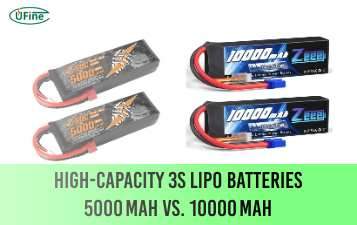Lithium batteries have revolutionized the way we use technology. They power our smartphones, laptops, electric vehicles, and countless other devices. However, understanding the capacity of these batteries can be a bit complex. Knowing the lithium battery capacity is crucial for making informed decisions about their use. This guide will walk you through what lithium battery capacity is, why it’s important, how to calculate it, and many other essential aspects.
Part 1. What is lithium battery capacity?
Lithium battery capacity is a measure of how much energy a battery can store and deliver. It is usually expressed in ampere-hours (Ah) or milliampere-hours (mAh). This measurement indicates how much electric charge the battery can provide over a specific period. For example, a battery with a capacity of 2000mAh can theoretically deliver 2000 milliamps (mA) for one hour or 1000 milliamps for two hours. It essentially tells you how long your battery will last under continuous use.
- Ampere-Hours (Ah): Commonly used for larger batteries, such as those in electric vehicles or large power tools.
- Milliampere-Hours (mAh): Often used for smaller batteries, like those in smartphones and portable electronics.
Part 2. Why should you know lithium battery capacity?
Understanding the capacity of a lithium battery is vital for several reasons:
- Estimating Battery Life: Knowing the capacity helps you predict how long the battery will last on a single charge. This is crucial for planning usage, especially for devices you rely on heavily.
- Device Compatibility: Ensuring the battery’s capacity matches your device’s power requirements is essential for optimal performance. Using a battery with insufficient capacity can lead to frequent recharges and potential device malfunctions.
- Optimizing Performance: A battery with the right capacity ensures your device performs efficiently. For instance, high-drain devices require batteries with higher capacities to function correctly.
- Cost-Effectiveness: Higher capacity batteries often come at a premium. Knowing the exact capacity you need helps you avoid overspending on unnecessary capacity.
- Safety Considerations: Using a battery with the wrong capacity can pose safety risks. Overloading a device with a battery that has too much capacity can lead to overheating and potential hazards.
Part 3. Lithium battery capacity calculation
Calculating the capacity of a lithium battery involves understanding a few basic principles. The capacity is typically calculated using the formula:
Capacity (Ah)= Energy (Wh)/Voltage (V)
Example Calculation:
Imagine you have a battery with an energy rating of 36 watt-hours (Wh) and a voltage of 12 volts (V). The calculation would be:
Capacity= 36Wh/12V=3Ah
Units of Measurement:
- Watt-Hours (Wh): A measure of energy indicating how much power the battery can deliver over time.
- Voltage (V): The potential difference between the battery’s terminals, contributing to the power delivered to the device.
Understanding these units and how they interact is key to grasping battery capacity.
Part 4. How to know the lithium battery capacity?
There are several practical methods to determine the capacity of a lithium battery:
- Manufacturer’s Label: The easiest way is to check the battery label. Most manufacturers print the capacity in mAh or Ah directly on the battery.
- User Manual: The device’s user manual often specifies the recommended battery capacity. This ensures you use a battery that aligns with the device’s power requirements.
- Multimeter Testing: For a more hands-on approach, you can use a multimeter to measure the current and voltage. Then, apply the capacity calculation formula.
- Online Tools and Apps: There are numerous online calculators and mobile apps designed to help you determine battery capacity. Inputting the battery specifications into these tools can give you an instant capacity reading.
Step-by-Step Multimeter Testing:
- Charge the Battery Fully: Ensure the battery is fully charged.
- Set Up the Multimeter: Configure the multimeter to measure current and voltage.
- Measure Voltage: Connect the multimeter to the battery terminals to measure the voltage.
- Measure Current: Measure the current the battery provides to a device.
- Calculate Capacity: Use the voltage and current values in the capacity formula.
Part 5. Lithium battery capacity and lithium battery life
Battery life and capacity are intimately linked. A higher capacity battery generally offers longer usage times between charges. However, several factors can influence this relationship. Here’s a simple method to estimate battery life:
Battery Life (hours)= Battery Capacity (Ah)/Device Current (A)
Example Calculation:
If you have a 2000mAh (2Ah) battery and your device uses 500mA (0.5A), the battery life would be:
Battery Life= 2Ah/0.5A =4hours
Factors Affecting Battery Life:
- Usage Patterns: Continuous heavy use drains the battery faster than intermittent use.
- Device Efficiency: More efficient devices can make better use of the available capacity.
- Temperature: Extreme temperatures can reduce battery efficiency and life.
- Age: As batteries age, their capacity diminishes, leading to shorter battery life.
- By understanding these factors, you can better manage and optimize the lifespan of your lithium battery.
Part 6. What affects lithium battery capacity?
Several factors can impact the capacity of a lithium battery. Understanding these can help you maintain your battery’s health and efficiency.
- Temperature: Lithium batteries perform best at moderate temperatures. Extreme cold can reduce capacity temporarily, while extreme heat can cause permanent damage.
- Charge Cycles: The number of times a battery is charged and discharged affects its capacity. Over time, the capacity diminishes with more cycles.
- Storage Conditions: Storing batteries at full charge or in hot environments can degrade their capacity over time. Ideally, store them at a cool, dry place and at around 50% charge.
- Usage Patterns: High discharge rates and frequent charging can lower the capacity. Avoiding deep discharges and maintaining moderate use can prolong capacity.
- Quality of Battery: Higher quality batteries typically have better materials and construction, which helps them maintain capacity longer.
Part 7. Is the higher the lithium battery capacity, the better?
Not necessarily. While higher capacity batteries do offer longer usage times, there are trade-offs to consider.
Pros of Higher Capacity:
- Longer Battery Life: More capacity means the battery can power your device for a longer period before needing a recharge.
- Better for High-Drain Devices: Devices that draw a lot of power benefit from higher capacity batteries.
Cons of Higher Capacity:
- Cost: Higher capacity batteries are generally more expensive.
- Size and Weight: They are often larger and heavier, which can be a disadvantage for portable devices.
- Compatibility: Not all devices are designed to handle higher capacity batteries. Using an incompatible battery can lead to performance issues or damage.
Choosing the right battery capacity depends on your specific needs and usage patterns. For everyday devices like smartphones, a moderate capacity might be sufficient. For high-drain devices or extended use, higher capacity batteries are beneficial. Balance your needs with the trade-offs to find the best fit.
By understanding lithium battery capacity, you can make informed decisions about the batteries you use. Whether it’s for your smartphone, laptop, or electric vehicle, knowing the capacity helps you optimize performance, ensure safety, and get the most out of your devices.
Related Tags:
More Articles

High‑Capacity 3S LiPo Batteries: 5000 mAh vs. 10000 mAh
Compare 3S LiPo 5000mAh vs 10000mAh batteries by weight, power, and use. Find the best fit for your drone, RC car, or boat setup.
Top 5 Applications for Small 3S LiPo Batteries
Small 3S LiPo batteries power drones, RC gear, wearables, and robotics with high energy and low weight. Making them ideal for compact electronics projects.
Building and Charging Your Own 3S LiPo Pack: A Step‑by‑Step Guide
Learn how to build, balance, and charge a 3S LiPo battery pack safely at home with this complete DIY guide for hobbyists and beginners.
How to Choose the Right LiPo Battery Plug Type?
Discover the best LiPo battery plug types, how to choose them, and expert tips for safe usage, soldering, and maintenance.
Choosing the Right Connector for Your 3S LiPo Battery
Choosing the right 3S LiPo connector depends on current, space, and use. Learn the pros and cons of XT60, JST, EC3, and more.





